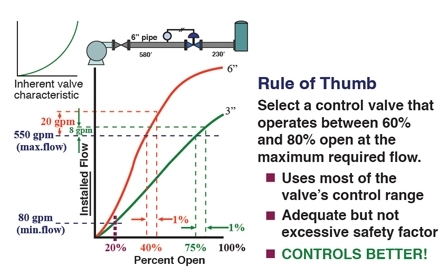Resources
5 Key Valve Sizing Points to Remember
It’s important to understand the importance of proper control valve sizing. If the valve is too small, it won’t be able to pass the required flow. In actual practice, undersized valves are fairly uncommon, but oversized valves are all too common.
An oversized control valve will cost more than is necessary, although that is only a minor point compared to the real problem. The real problem is that an oversized valve will be very sensitive, meaning small changes in valve position will cause large changes in flow. This will make it difficult, or even impossible, for it to adjust exactly to the required flow. In general, the more oversized a control valve is, the poorer the accuracy of control will be.
The figure below shows graphs of the installed characteristics of two different valves in the same system. These are both segment ball valves that have equal percentage inherent characteristics, and the system has a lot of pipe. Note that up to the specified maximum flow rate of 550 GPM both have reasonable linear installed characteristics. The 3” valve is a properly sized valve and the 6” valve is an oversized valve. The reason that the 3” valve is a properly sized valve is because it meets the criterion of the rule of thumb of being between 60 percent and 80 percent open at the maximum required flow of 550 GPM. This rule of thumb has served valve users well because it gives a good balance between using as much of the valve’s control range as possible, giving good flow resolution, while providing adequate safety factor. (The 3” valve can increase flow about 20 percent above 550 GPM which should be adequate, while the 6” valve can increase the flow about 60 percent above 550 GPM, which is more than should ever be required.)
Starting at 550 GPM, if the properly sized valve opens by 1 percentage point the flow will increase by 8 GPM. If the oversized valve opens by 1 percentage point the flow will increase by 20 GPM.

Comparison of a properly sized control valve and an oversized control valve
Although not always possible, it is also preferable to have the minimum opening no less than 20 percent to provide some safety factor at the low end. Normally, control valve manufacturers publish Cv values in 10 percent increments beginning at 10 percent open, so it’s impossible to know what happens to the Cv below that point.
It is not unusual to find properly sized full-ball, segment-ball, and high-performance butterfly valves that are two sizes smaller than the line and properly sized globe valves that are one size smaller than the line. This is not a rule, but just the way things often turn out. If a valve is sized, and it turns out to be different than these, it is a good idea to check the work. A mistake may have been made. Additionally, the person who sized the pipe may have made a mistake.
Most people consider it poor piping practice to use a control valve that is less than one half the line size or larger than the line size.
Here are some points to remember:
- If a set of loop-tuning parameters only works at one end of the control range and not the other, the valve’s flow characteristic is most likely the wrong one (Learn more about flow characteristics in “Part I: An Insider’s Guide to Valve Sizing & Selection” in the February 2015 issue of Flow Control.)
- If a system has a lot of pipe and/or other pressure-consuming elements, or a pressure source that decreases with increasing flow, an equal percentage valve will usually be the best choice
- If a system has very little pipe and/or other pressure-consuming elements and has a pressure source that doesn’t decrease with increasing flow, a linear valve will usually be the best choice
- A control valve that is sized to operate around 60 percent to 80 percent open at the maximum required flow and not much less than 20 percent open at the minimum required flow will give the best control
- Oversized control valves are very common
Jon F. Monsen, Ph.D., P.E., is a control valve technology specialist at Valin Corporation, with more than 30 years' experience. He has lectured nationally and internationally on the subjects of control valve application and sizing, and is the author of the chapter on "Computerized Control Valve Sizing" in the ISA Practical Guides book on Control Valves. He is also the author of the book “Control Valve Application Technology: Techniques and Considerations for Properly Selecting the Right Control Valve. For more information, visit www.valin.com.
Article featured in Flow Control magazine.
A lesson for me is that I need to involve you earlier in the program.
You were tireless in your support and it will not be forgotten!
Latest from Valin's Blog
The NIST Chemistry WebBook contains a great deal of information regarding the properties of a broad range of chemicals and is helpful for those who deal with chemical processes.In this article, Jon Monsen has outlined the procedure for finding the actual density of a gas using the WebBook.
